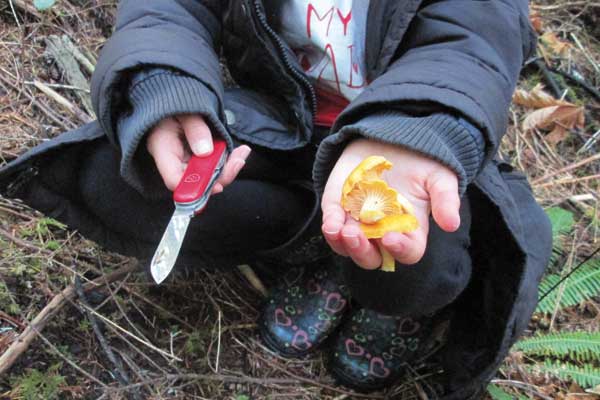
PO2 Bertrand Larocque and his daughters Casandra and Milla show off a Cantharellus cibarius, commonly known as the chanterelle, that they picked during a recent trip to a forest near Port Renfrew.
Peter Mallett, Staff writer
Not long after the first rainy days at the end of summer, a vast cornucopia of colorful mushrooms pop up at the base of trees and the duff of forest floors of the Pacific Northwest. Along with them comes an army of mushroom pickers.
One-by-one, armed with specially designed harvesting knives, they hike into the lush forests of Vancouver Island in search of the fruits of fungus.
For outdoor enthusiasts, mushroom picking not only provides a healthy outdoor activity, but also brings a greater understanding of the Island’s diverse and sensitive ecosystem. With the right safety precautions, their harvest also provides them an unparalleled culinary delight.
“After a day of hiking and bushwhacking you begin to get the aroma of those Chanterelle mushrooms on your fingers,” says CPO2 Yvan Vallières an instructor at Fleet School. “There is nothing like it, being outdoors and cooking a fresh batch of Chanterelle mushrooms that you have just picked.”
The mushroom season is a short-lived one and typically runs from late August until mid to late November when the first hard frost arrives.
CPO2 Vallières and other mushroom seekers use specially designed Opinel mushroom knives and other similar blades to carefully separate the mushrooms from their stems in order to harvest their crops.
A life-long outdoor enthusiast originally from Gatineau, Que., CPO2 Vallières began mushroom picking 10 years ago and says he was “instantly hooked.”
On fall weekends, he and his girlfriend Claudette Poirier hop in their camper van and “get away from it all.” The pair travel to remote locations on Vancouver Island, set up camp, and spend their weekend hiking through the bush searching for some of the 30 varieties of edible mushrooms.
“After we are finished picking, the best part is unwinding at our camp,” says CPO2 Vallières. “We love it, there is no connectivity with the outside world and normally not a single other camper in sight. It’s the perfect place to relax and enjoy a glass of wine with a gourmet meal.”
There is also a spring mushroom season. Morel mushrooms come to life in woodland areas devastated by forest fires and normally grow during April and May.
“So far I have not found a good spot for them, but I am confident I will,” says CPO2 Vallières.
The love of mushroom picking has also grown on another outdoorsman and Fleet School instructor, PO2 Bertrand Larocque. PO2 Larocque grew up in the Montreal suburb of St-Bruno de Montarville and began picking when he moved to the Island in 2006.
For him, mushroom picking is a weekend outing for the whole family. His wife Janna Sagimbekova and their two children Milla, 6, and Cassandra, 8, form a mushroom quartet. They comb the forest floor and tree bases mostly looking for Chanterelle, Pine, and Cauliflower mushrooms.
“It’s a free source of food but it’s also a good healthy activity for my whole family,” says PO2 Larocque. “It gets us walking and hiking outdoors and since my wife and I both have a wildlife management degree we have always been into the outdoors.”
But along with the feeling of adventure and exhilaration, being alone in the wilderness requires a great deal of knowledge, and both caution and sensitivity are prerequisites.
Mushroom pickers are encouraged to tread lightly to not disturb the forest floor and the complex root systems known as the mycelium, which is really the living organism which the mushrooms grow from.
By law, mushroom pickers are restricted from harvesting on federal or provincial parkland, federal defence lands, and protected and recreational areas, while permission is required to pick mushroom on leased public land, private land and First Nations reserve lands.
The hobby can also become a serious health hazard. Both PO2 Larocque and CPO2 Vallières say while mushroom pickers and hikers often take precautions against the threat of encountering wild animals such as bears and cougars by arming themselves with bear spray and weapons, the biggest threat to personal safety is often the mushrooms themselves.
Of the estimated 18,000 mushroom species on Vancouver Island many are poisonous. Consuming the wrong species can cause a wide range of symptoms, from allergic reactions, stomach cramps, nausea and hallucinations, to liver and kidney damage or even death.
“I never pick or consume anything I can’t identify immediately,” said PO2 Larocque.
“Walking in the forest, you will see all kinds of beautiful mushrooms like the amanitas,” said CPO2 Vallières. “Some are red, yellow or green with white sprinkles on top. They look beautiful but are very poisonous and should be left alone. Death cap is another one.”
Each year there are also the news reports of mushroom pickers who get lost in the bush.
Larocque’s wife Janna nearly became lost during a hike in the bush near Port Renfrew on Oct. 17. Thankfully his military training and work experience in a Z.E.C. as a Parcs Quebec worker kicked in and he was able to locate her.
“Little things can happen in the wilderness and become big things,” says PO2 Larocque. “You are not used to the environment, so simple things like a cell phone, a GPS, a compass or a whistle could go a long way in saving your life.”
The benefits far out weigh the dangers and PO2 Larocque concludes, “The best thing to do is use caution and common sense.”









